Install the app
How to install the app on iOS
Follow along with the video below to see how to install our site as a web app on your home screen.
Note: This feature may not be available in some browsers.
You are using an out of date browser. It may not display this or other websites correctly.
You should upgrade or use an alternative browser.
You should upgrade or use an alternative browser.
Uutisia Saksasta
- Viestiketjun aloittaja vehamala
- Aloitus PVM
Sydän itkee kattoa tätä hulluutta.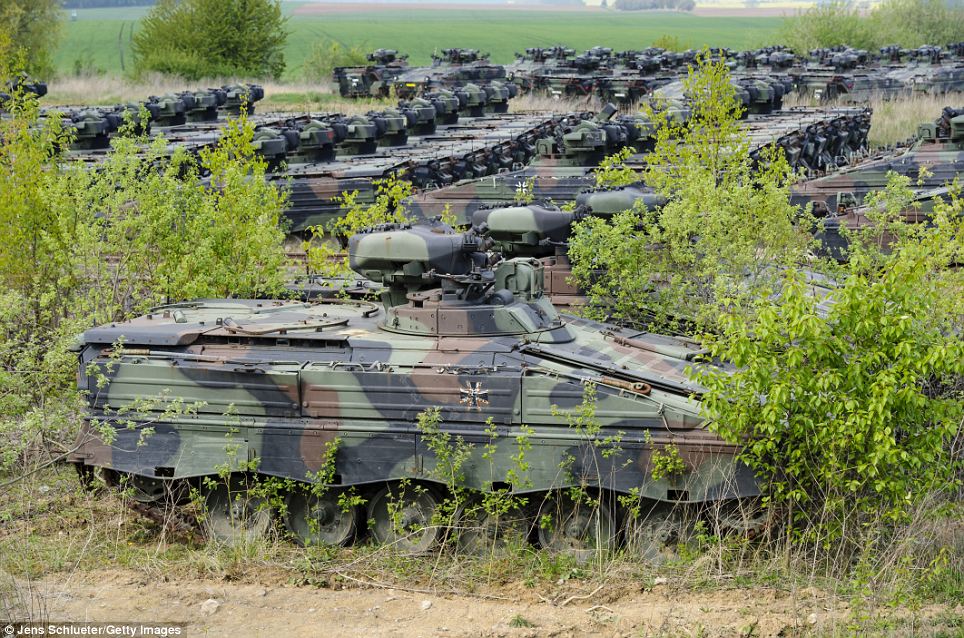
+24
Weeds and bushes have grown up around the tanks, which date back to the early 1970s
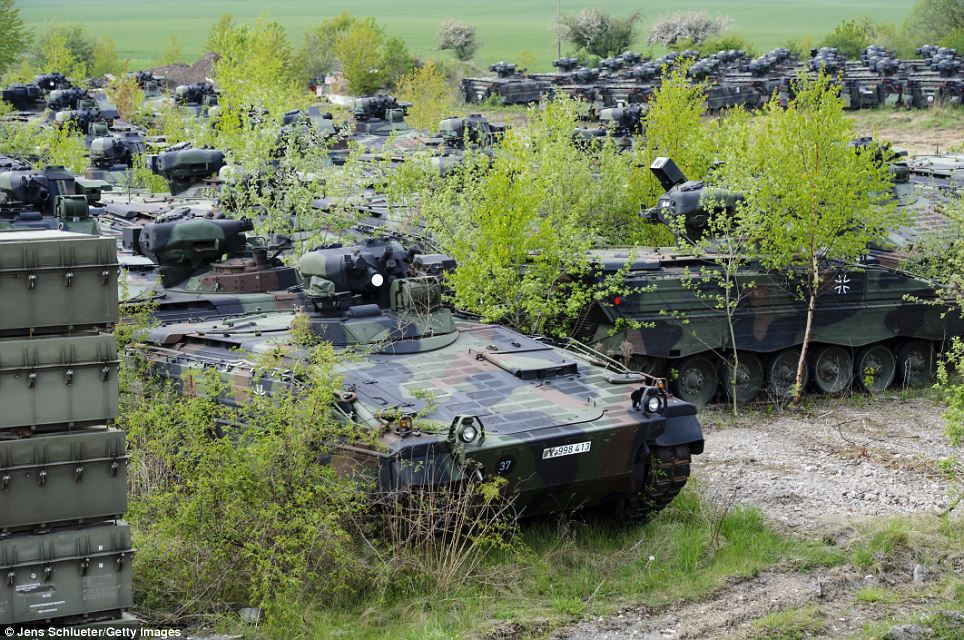
+24
The Marder is a German infantry fighting vehicle operated by the German Army as the main weapon of the Panzergrenadiere from the 1970s through the present day
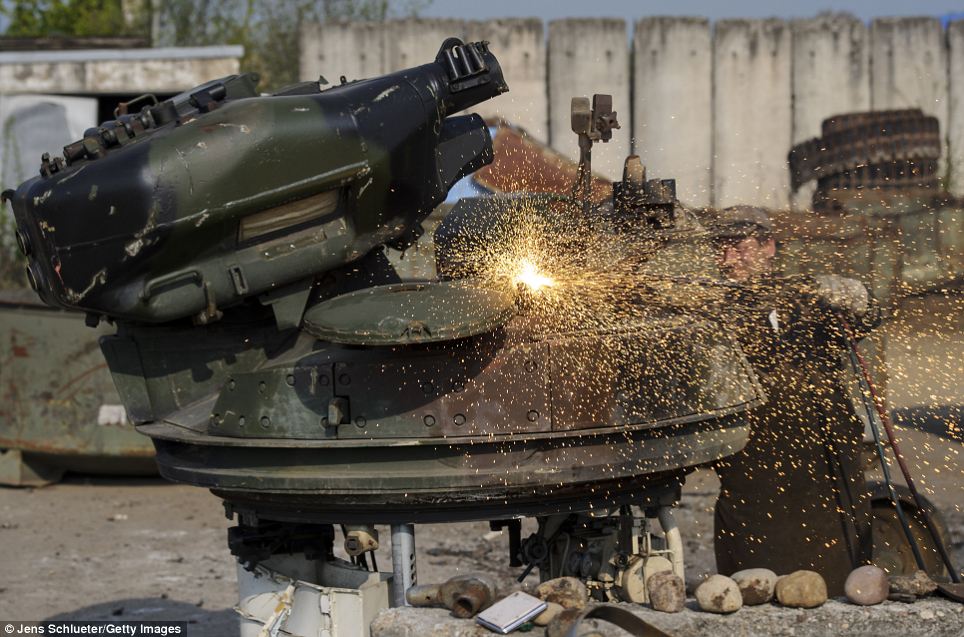
+24
A technician uses a welder's torch to cut parts off a Marder light tank: Primary armament is the 20 mm Rheinmetall MK 20 Rh202 autocannon mounted in the small two-man turret
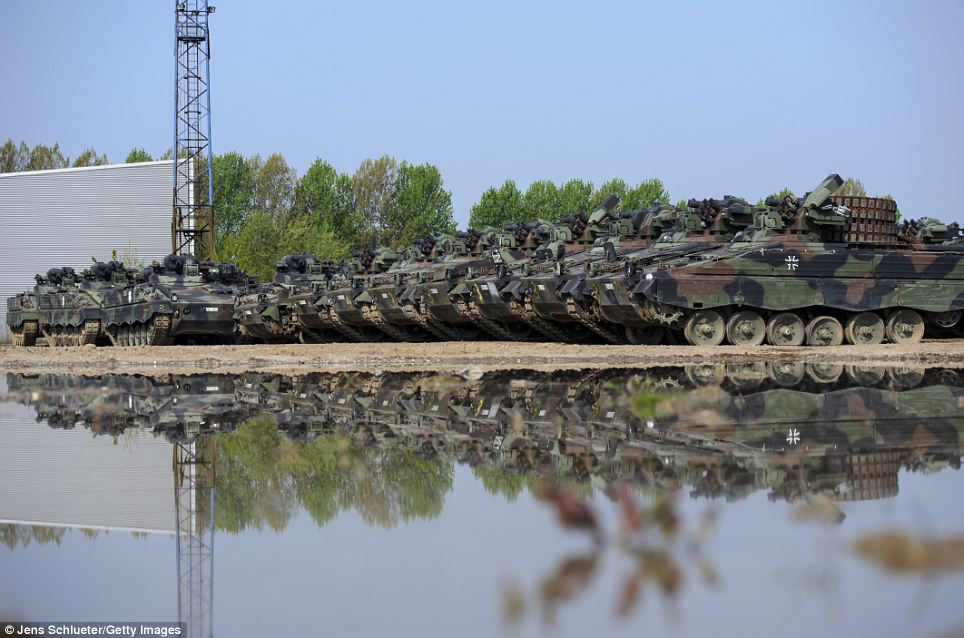
+24
Tough: The hull of the Marder is all welded steel, giving protection from small-arms fire and shell fragments with the front strong enough to resist up to 20mm APDS rounds
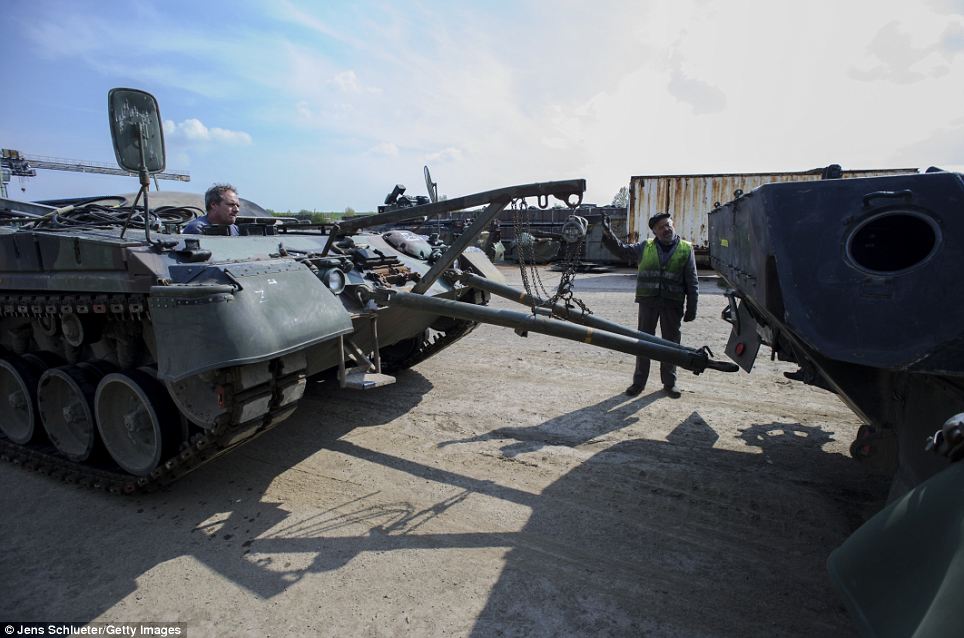
+24
Still working: A technician uses a converted Gepard anti-aircraft tank to move a other Gepard across the yard
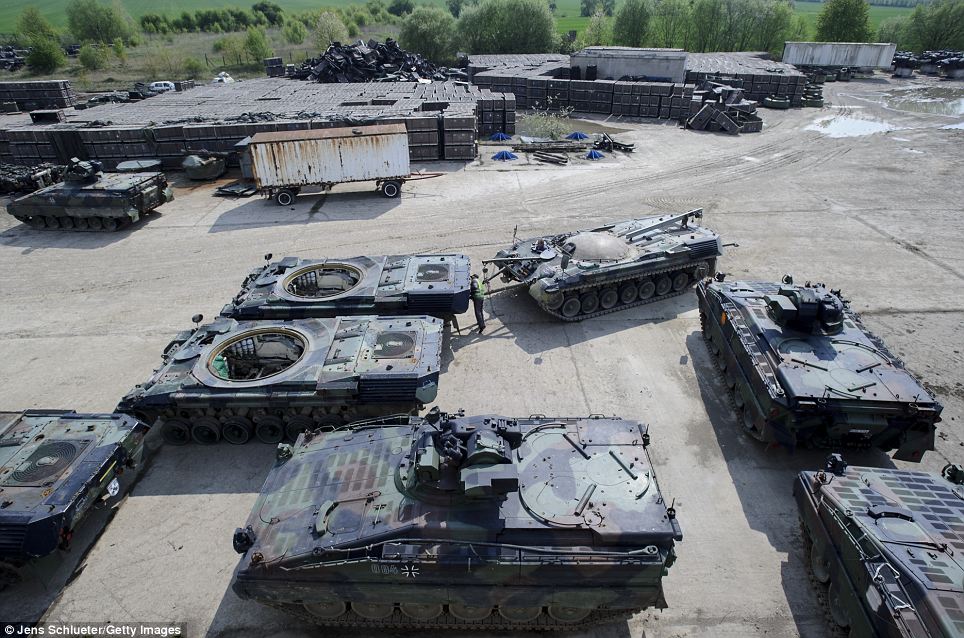
+24
Shunt: There are few other vehicles that could be used to move a tank. This photograph shows the manoeuvre from a second angle
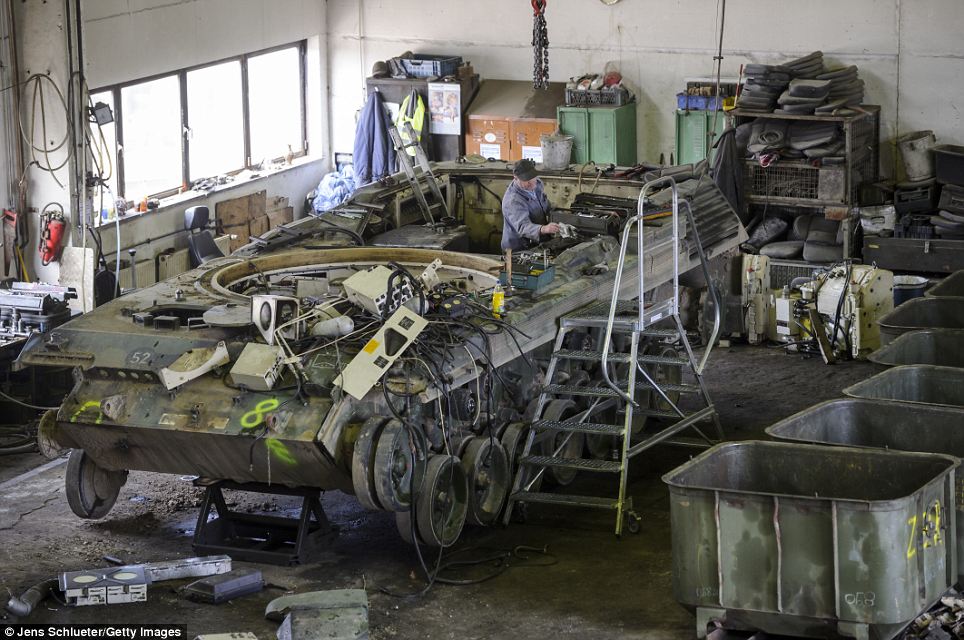
+24
A Gepard tank is seen here in a state of carefree undress: The Gepard once constituted a cornerstone of the air defence of the Bundeswehr and a number of other Nato countries

+24
A technician uses a welder's torch to cut the cannon of a Leopard main battle tank that once belonged to the Bundeswehr
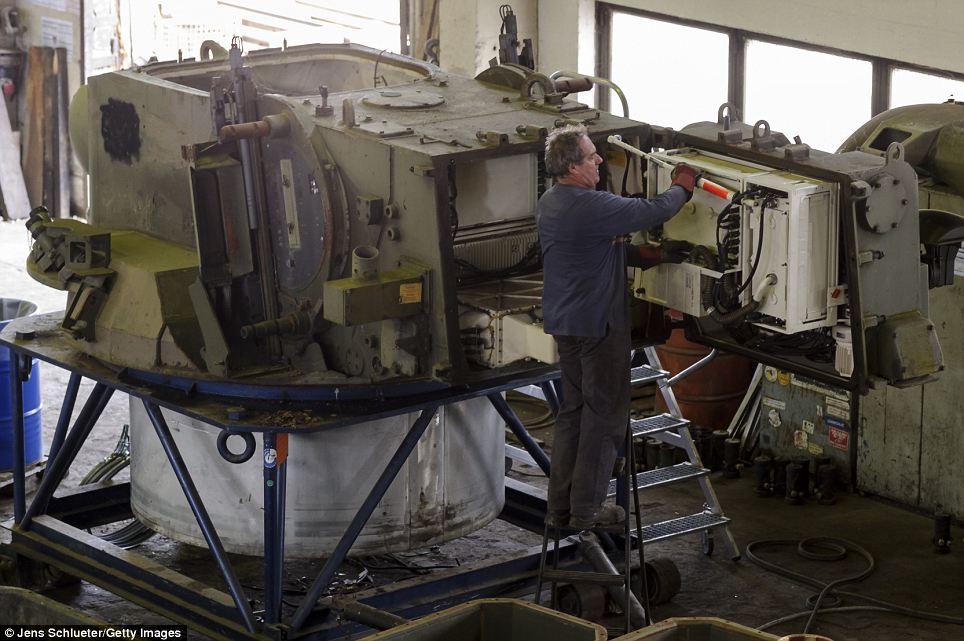
+24
A technician cuts parts off a Leopard: Introduced in 1965 the Leopard quickly became a standard of European forces, and eventually served as the main battle tank in over a dozen countries worldwide
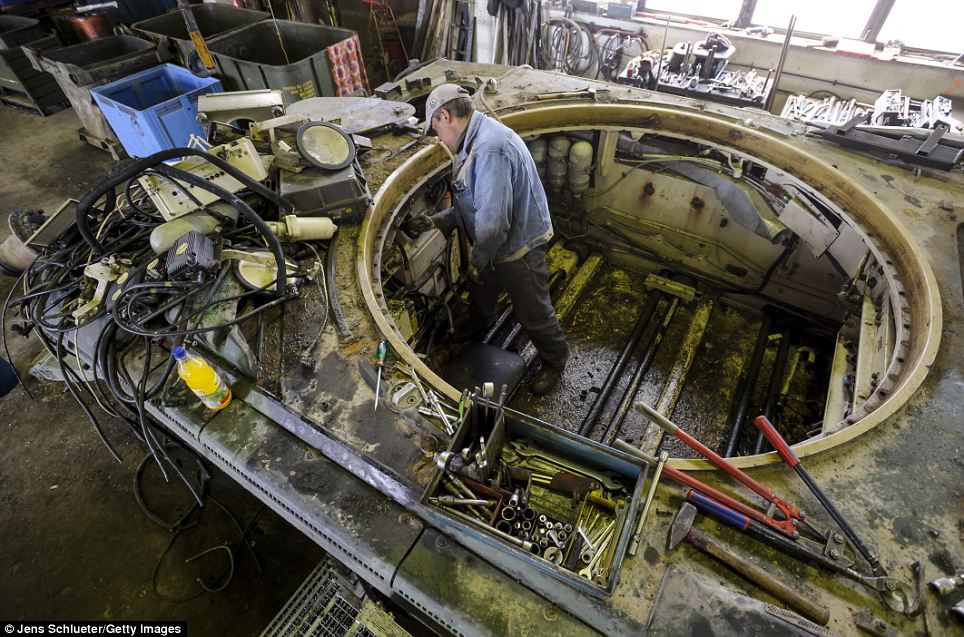
+24
Oily and old: A technician dismantles a Gepard
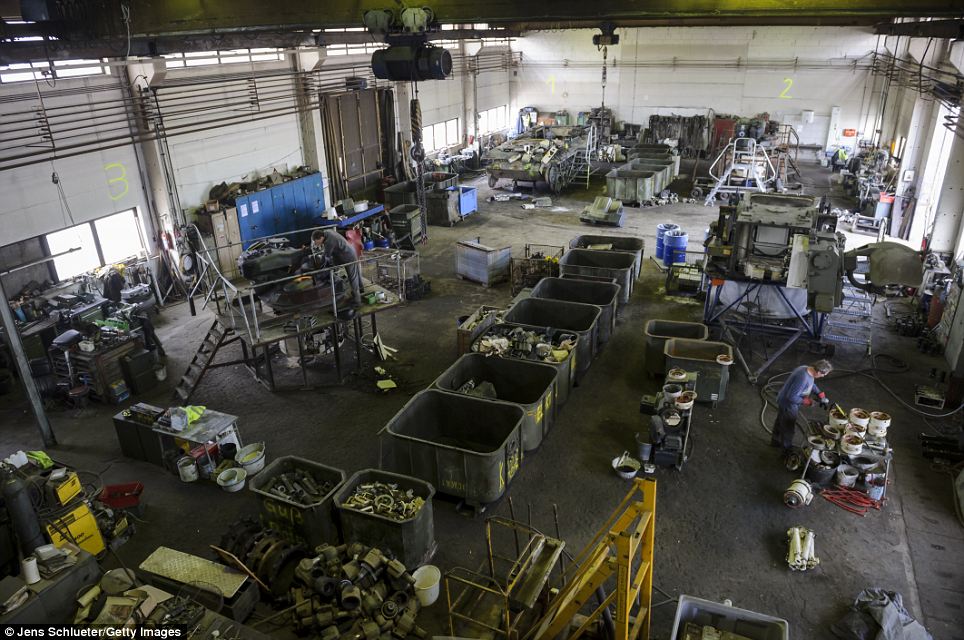
+24
Recycling: The components will all be melted down and the metal from them reused elsewhere
Huono. Huonoimmasta päästä SA-varastojen purkautuessa tuhotaan. Parhaat on modattu omaan käyttöön A4:ksi ja A5:ksi jo. Rungot ovat väsyneitä, asejärjestelmä (erit MILAN) on vanhentunut ja poistuvaa materiaalia. Saksalaisen systeemin mukaan koneet laitetaan varastoon kun niillä on 1/3 osa elinikää jäljellä (2/3 osaa on käytetty koulutukseen). Esim. jos putken elinikä olisi vaikkapa 30k ls niin jäljellä olisi alle 10k ls joka tarkoittaisi että ampumakoulutusta tulisi rajoittaa tai ainakin kieltää täysin APFSDS-T/TPFSDS-T:t. Myös tarkkuus ja mekaanisten vikojen todennäköisyys olisi jo rauhan aikana suuri huoltoa työllistävä ylimääräinen ja koulusta häiritsevä tekijä. Sama koskee alustan käytettäviä km:ä. Suurin ongelma on elektroniikan vanhentuminen ja varaosien puute vanhaan elektroniikkaan hajoavien tilalle kun Saksa noin 5-v sisään luopuu järjestelmästä kokonaan. Osa modernisointi olisi tehtävä ja se tappaisi kustannus tehokkuuden. Erityisesti lämpökamerat kärsivät suuresti ikääntymisestä. Jopa täysin käyttämättömät varastoista otetut 80-luvun lämppärit ovat paikalleen asennettuna kestäneet erittäin huonosti käyttöä, kun taas uusilla varaosilla korjatut ovat toimineet paremmin. Pitäisikö lämpökameravalmistaja yllä tukea vanhentuneelle lämpökameralle meidän takiamme? Kyllä varmasti kun tarpeeksi maksamme, mutta onko hinta-laatusuhde enään kohdallaan?Sydäntä särkee. Tukuittain Mardereita pataan...Mikäköhän keskimäärin noiden vaunujen kunto?
Toki nuo sen pyörätraktorin olisi voittanut suorituskyvyssä mennen tullen... eri asia on onko meillä varaa uuteen järjestelmään ja onko panos tuotos suhde riittävän hyvä? Mielestäni ei tällä rahoituksella.
Viimeksi muokattu:
kimmo.j
Greatest Leader
Komppaan CV9030FINiä, nuo vaunut ovat kulunutta ja vanhaa kamaa. Niiden taistelukyky on laskenut merkittävästi ja valmistajan tuki lakannut.
Marder on muutenkin hyvin vanha tuote ja on merkittävästi heikompi työkalu kuin CV. Toki noita voisi saada halvalla, mutta kannattaako ostaa valmiiksi huonoa?
Muutenkin, jos Marder olisi ollut niin ylivoimainen vaunu kuin jotkut haluavat ajatella, miksi se ei menestynyt vientimarkkinoilla, niin...
Marder on muutenkin hyvin vanha tuote ja on merkittävästi heikompi työkalu kuin CV. Toki noita voisi saada halvalla, mutta kannattaako ostaa valmiiksi huonoa?
Muutenkin, jos Marder olisi ollut niin ylivoimainen vaunu kuin jotkut haluavat ajatella, miksi se ei menestynyt vientimarkkinoilla, niin...
PJ85
Eversti
Pidän CV:tä ehdottomasti maailman parhaana rynnpsv:nä, ja kun niiden kanssa on jonkin verran tullut pelattuakkin (jalkamiehenä tosin) niin ei voi kuin kiitosta antaa. Yksi asia siinä jonkinverran häiritsee, ja se on pstohjuksen puute. Koska en ole asiantuntija, niin en osaa sanoa kuinka suuri tuo puute on?
Ei merkittävä suomalaisilla ampumaetäisyyksillä ja peitteisen maaston takia (huom. nämä kaksi asiaa EIVÄT ole sama asia). Kannattaa huomata, että myöskään BMP-2 kaluston ohjuksia ei ole korvattu vaan ne poistettiin käytöstä marginaalisen käytettävyyden takia (eikä päivitetä myöskään -2M:ään). RYNNPSV:t toimivat aina yhteistoiminnassa TSTPSV:n kanssa jotka hoitavat osan tilanteista joissa raskasta PST-tulta tarvitaan (pikatilanteet, hyökkäävä toiminta) ja osissa tilanteissa on jopa tehokkaampaa käyttää jalkautuvia partioita kun vaunuun asennettua ohjusta (väijytys, viivytys). Projekti jossa osaan CV9030FIN vaunuista olisi aseistettu torniin asennetuilla PSTOHJ00:lla lopetettiin jo vuosia sitten hinnan vs. saatava hyöty suhteen ollessa kyseenalainen. Tietääkseni ko projektin rahoituksella ostettiin lisää ohjuksia maajalustoihin sen sijaan.Pidän CV:tä ehdottomasti maailman parhaana rynnpsv:nä, ja kun niiden kanssa on jonkin verran tullut pelattuakkin (jalkamiehenä tosin) niin ei voi kuin kiitosta antaa. Yksi asia siinä jonkinverran häiritsee, ja se on pstohjuksen puute. Koska en ole asiantuntija, niin en osaa sanoa kuinka suuri tuo puute on?
miheikki
Greatest Leader
Tehdään Saksasta siirtomaa.
http://www.spiegel.de/politik/ausla...ngen-laut-spiegel-derzeit-nicht-a-994079.html
Pertti Rönkkö
14 t · iOS ·
Saksan armeija on teknisesti niin rämätilassa, ettei se pysty täyttämään kaikilta osin enää NATO- velvoitteitaan, kertoo Spiegel-lehti. Puolustusministeriö on vahvistanut tiedon. Erityisen huonossa kunnossa on lentokalusto.
http://www.spiegel.de/politik/ausla...ngen-laut-spiegel-derzeit-nicht-a-994079.html
fulcrum
Greatest Leader
Ylläolevaan uutiseen liittyen, taulukko lontoon kielellä jossa on listattu käytettävissä olevan kaluston määrä. NH 90 pahnan pohjimmaisena, vain 8 operatiivista kopteria.
Code:
System On the books Available Deployable Remarks
Army
Leopard 2 273 232 232 41 in depot maintenance
Marder 406 280 280 126 in depot maintenance
Fuchs 708 538 538 170 in depot maintenance
Boxer 180 70 70 110 in depot maintenance; not yet mature in support
Fennek 218 185 185 33 in depot maintenance
PzH 2000 89 76 76 13 in depot maintenance
MLRS 20 17 17 3 in depot maintenance
Tiger 31 10 10 21 in depot maintenance; not yet mature in support
NH 90 33 8 8 25 in depot maintenance
Air Force
Eurofighter 109 74 42 32 in industrial maintanance, 3 technical training
Tornado 89 66 38 17 in industrial maintenance, 2 technical training, 4 being phased out
Transall 56 43 24 9 in depot maintenance, 9 industrial maintenance, 2 technical training
CH-53 83 43 16 37 in industrial maintenance, 1 type evaluation, 1 technical training, 1 test center
Patriot 13 12 7 1 tactical training
Navy
Frigates 11 8 7 difference due to maintenance cycle of units
Minesweepers 17 11 6 difference due to maintenance cycle of units
Corvettes 5 2 2 difference due to maintenance cycle of units
ELINT vessels 3 2 1 difference due to maintenance cycle of units
Submarines 4 1 1 unforeseen repairs
Orion 8 5 2
Seaking 21 15 3 unforeseen repairs, spare part obsolencies
Sealynx 22 18 4 unforeseen repairs, spare part obsolenciesErityisesti kopterien tilanne näyttää aika surulliselta. Herra Guttenbergin visionäärinen päätös säästää varaosissa ei ilmeisesti sitten ollut se fiksuin ratkaisu.
Totta! Olisi mielenkiintoista tietää vastaavat luvut Suomen osalta. No, koska erityisolosuhteet ei lukuja laiteta julki...
miheikki
Greatest Leader
Saksakin tarvitsee lähinnä kevyesti panssaroitua pyöräkalustoa seuraavaan sotaansa.
Germany: Holy War Erupts in Hamburg
by Soeren Kern
October 15, 2014 at 5:00 am
http://www.gatestoneinstitute.org/4780/hamburg-holy-war
"We are living in Hamburgistan." — Daniel Abdin, imam of Hamburg's Al-Nour Mosque.
One politician has been repeatedly threatened with beheading as the price to pay for leading a fundraising campaign to provide food and water for Kurds in northern Iraq.
"As a society we must ask ourselves: how can it be that people who live in Germany and... born and raised here, are supporters of a brutal, inhuman and fundamentalist group such as the IS and attack peaceful protestors with knives, sticks and machetes. Here in Germany, the IS threatens to become a refuge for frustrated young people…." —Claudia Roth, Vice-President, German Parliament.
"Under no circumstances should [politicians who receive death threats] give in and change their stance, otherwise the extremists will have achieved their objectives." — Wolfgang Bosbach, CDU official.
Parts of downtown Hamburg, the second-largest city in Germany, resembled a war zone after hundreds of supporters of the jihadist group Islamic State [IS] engaged in bloody street clashes with ethnic Kurds.
The violence—which police say was as ferocious as anything seen in Germany in recent memory—is fuelling a sense of foreboding about the spillover effects of the fighting in Syria and Iraq.
Some analysts believe that rival Muslim groups in Germany are deliberately exploiting the ethnic and religious tensions in the Middle East to stir up trouble on the streets of Europe.
The unrest began on the evening of October 7, when around 400 Kurds gathered outside the Al-Nour mosque near the central train station in Hamburg's St. George district to protest against IS attacks on the Syrian Kurdish town of Kobani.
According to police, the initially peaceful protest turned violent when the Kurds were confronted by a rival group of around 400 Salafists armed with baseball bats, brass knuckles, knives, machetes and metal rods used to hold meat in kebab restaurants.
In the melee that followed, more than a dozen people were injured, including one person who nearly had his leg chopped off by someone wielding a machete, and another person who was stabbed in the stomach with a kebab rod.
Some 1,300 police officers, brandishing batons and accompanied by water cannons, were deployed to halt the clashes, which lasted into the early morning hours of October 8. In the final tally, hundreds of weapons were seized and 22 people were arrested.
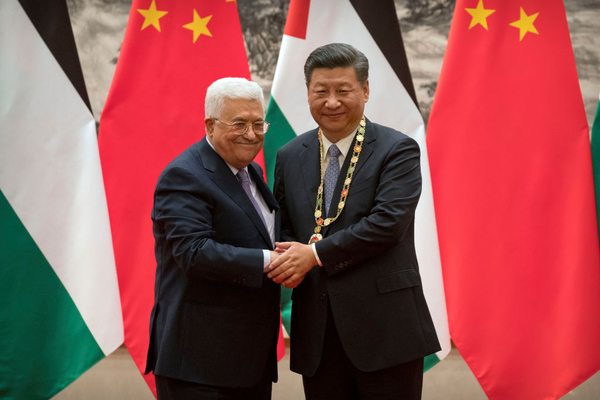
German police in riot gear, accompanied by armored vehicles and water cannons, charge into a street battle between Kurds and radical Islamists in Hamburg, Oct. 8, 2014. (Image source: N24 video screenshot)
"I had the feeling that we are living in Hamburgistan," the imam of the Al-Nour mosque, Daniel Abdin, told the German newsmagazine Der Spiegel. "The atmosphere was very, very explosive."
Police said they were shocked by what they described as an unprecedented level of violence.
In an interview with the newspaper Passau Neue Presse, the chairman of the German Police Union, Rainer Wendt, reported that police in Hamburg "experienced life-threatening brute force" by perpetrators who were armed "to the teeth." Wendt warned that the IS-Kurdish conflict is "threatening to unleash a proxy war on German soil."
A police official in Hamburg, Gerhard Kirsch, said the level of the violence points to a new "dangerous dimension" that "we have so far not seen at other demonstrations."
The chairman of the German Police Union in Hamburg, Joachim Lenders, described the viciousness as unprecedented. "The violence in the early hours of Wednesday was of a ruthless and inhuman brutality as I have rarely experienced," he said, adding that without the timely deployment of the police there would almost certainly have been fatalities. Lenders added:
"If in the middle of Hamburg 800 hostile people are fighting each other with machetes, knives and iron rods, there must be consequences for the perpetrators. Politically motivated extremists and religious fanatics have brought a conflict to Hamburg that cannot be solved here."
On the same day of the unrest in Hamburg, dozens of mostly Chechen Muslim immigrants clashed with Kurdish Yazidis—a non-Arab and non-Muslim minority that has been persecuted by IS—in Celle, a town in Lower Saxony that is home to more than 7,000 Yazidis. Police said the violence, in which nine people were injured, was fuelled via social media after radical Muslim preachers sent out a call to Islamists to confront the Yazidis.
The conflict in Celle was reminiscent of—but far more violent than—the Muslim-Yazidi clashes that occurred in the eastern Westphalian town of Herford in August.
"Solidarity with Kobani" demonstrations have also taken place in Munich—where protestors waving large Kurdish flags occupied the offices of the Christian Social Union [CSU], the Bavaria-based sister party to Germany's ruling Christian Democratic Union party [CDU]—as well as in the western German cities of Berlin, Bremen, Göttingen, Hamm, Hannover, Kiel, Oldenburg and Stuttgart.
Germany is home to an estimated 4.3 million Muslims, one million Kurds and 60,000 Yazidis. According to the 2013 annual report (published in June 2014) of the German domestic intelligence agency, the Bundesamt für Verfassungsschutz [BfV], Germany is also home to 30 active Islamist groups and 43,000 Islamists, including 950 members of the Lebanese terrorist group Hezbollah, 1,300 members of the Muslim Brotherhood and 5,500 Salafists.
Salafism is a radically anti-Western ideology that openly seeks to replace democracy in Germany (and in other parts of the West) with an Islamic government based on Sharia law.
Although Salafists make up only a fraction of the Muslims in Germany, authorities are increasingly concerned that many of those attracted to Salafi ideology are impressionable young Muslims who are susceptible to perpetrating terrorist acts in the name of Islam.
German authorities have faced criticism for being overly complacent concerning the rise of Salafism in the country. On October 2, for example, the German public broadcaster ARD revealed that German officials have for many years pursued a secret policy of encouraging German Islamists to travel abroad rather than to invest in counter-radicalization efforts. According to ARD, the general idea was that if German jihadists were intent on committing terrorist acts, it would be better that they do so somewhere else than inside Germany.
The overall aim was to "protect our population" by exporting the problem, the head of counter-terrorism for Bavarian Police, Ludwig Schierghofer, told ARD. The reasoning was "to bring those persons who pose a risk that they will commit terrorist attacks outside of the country," he said. "If someone had become radicalized and wanted to leave, then the policy was to allow them to leave or even accelerate their departure by various means."
An estimated 450 German Muslims have traveled to Syria and Iraq, and at least 100 are now believed to have returned to Germany.
Meanwhile, a growing number of German politicians are receiving death threats from German Salafists.
One such politician, Tobias Huch of the (classical liberal) Free Democratic Party [FDP], has been repeatedly threatened with beheading as the price to pay for leading a fundraising campaign to provide food and water for Kurds in northern Iraq.
"I am not afraid, but I have become more careful," says Huch, who now receives police protection. He says he has altered his daily comings and goings in order to be less predictable. Among other lifestyle changes, he has cut out regular visits to restaurants, pubs and other public venues.
Another politician, Ismail Tipi of the ruling CDU, is paying the price for criticizing the rise of Salafism in Germany. "I receive threats almost every day," Tipi says. "The death threats against me have no limits. The Salafists want to behead me, shoot me, stone me, execute me and they have many other death wishes for me."
According to CDU official Wolfgang Bosbach, politicians who receive death threats should not allow themselves to be intimidated. "Under no circumstances should they give in and change their stance, otherwise the extremists will have achieved their objectives."
The head of the FDP, Christian Lindner agrees. "It is unacceptable for Liberals to allow religious extremists to take an ax to the central values of our constitution. We will not give in to threats and intimidation, rather we will demand the determined reaction of the rule of law."
By contrast, the Vice President of the German Parliament, Claudia Roth of the Green Party, believes the growing radicalization of Muslims in Germany points to problems in German society. In an interview with the newspaperDie Welt, Roth said:
"The violent clashes between Kurdish and Islamist groups in German cities and on German streets refer more to internal German problems than the situation in northern Syria and northern Iraq.
"As a society we must ask ourselves: how can it be that people who live in Germany and in large part are born and raised here, are supporters of a brutal, inhuman and fundamentalist terror group such as the IS and attack peaceful protestors with knives, sticks and machetes. Here in Germany, the IS threatens to become a refuge for frustrated young people who lack future prospects."
While politicians debate causes and solutions to the problem of radical Islam, police throughout Germany remain on alert for more violence.
Soeren Kern is a Senior Fellow at the New York-based Gatestone Institute. He is also Senior Fellow for European Politics at the Madrid-based Grupo de Estudios Estratégicos / Strategic Studies Group. Follow him on Facebook and on Twitter.
RPG83
Soome Majori
Laitetaan tämäkin, vaikkei olekaan enää mikään uutinen.
http://www.spiegel.de/politik/deuts...fuer-auslandseinsaetze-staerken-a-997221.html
Sikäli kuin lyhyellä koulusaksallani ja Google Translatella saan jotain tolkkua tuosta, ovat hallituksen maanpuolustus-suuntautuneet poliitikot alkaneet vaatia lisää rahaa Bundeswehrin ohjelmiin. Merkittävin ohjelma olisi uuden sukupolven tst-panssarivaunun kehitys, siis Leopard 3! Muita uutisessa mainittuja juttuja ovat Infanterist der Zukunft -ohjelman (tulevaisuuden taistelija) kiihdyttäminen (Saksassa sama kuin täällä, parhaita varusteita riittää lähinnä kriha-porukoille) ja päätös Meads-ilmatorjuntaohjusjärjestelmän hankinnasta.
On kyllä korkea aikakin ryhtyä kehittämään täysin uutta taistelupanssarivaunua. Olisikohan meilläkin varaa siihen sitten 30-luvulla? Melkein toivoisin tulevan pikku hiljaa käyttöä vanhoille vaunuillemme (A4 ja A6), niin PV saisi hyvän syyn hankkia tuollaisen uuden sukupolven vaunun heti ensimmäisten joukossa...
http://www.spiegel.de/politik/deuts...fuer-auslandseinsaetze-staerken-a-997221.html
Rüstungsprojekte: Koalitionspolitiker wollen mehr Panzer für die Bundeswehr


DPA
Kampfpanzer "Leopard 2 A6" im Übungseinsatz: Nachrüstung geplant
Verteidigungsexperten der Großen Koalition fordern mehr Geld für die Armee, vor allem für neue Panzer - und eine schnelle Entscheidung über das geplante Luftabwehrsystem Meads.
Berlin - Die Große Koalition soll die Bundeswehr weiter aufrüsten: Als Konsequenz aus der Ukraine-Krise plädieren die Verteidigungspolitiker von Union und SPD dafür, deutlich mehr Panzer als bislang geplant anzuschaffen. Die angestrebte Zahl von 225 Leopard-Panzern und 190 Radpanzern des Typs "Boxer" sei angesichts der aktuellen Sicherheitslage nicht mehr angemessen. Das schreiben die Verteidigungsexperten der Koalition laut der Nachrichtenagentur Reuters in ihren Anträgen für den Haushalt 2015.
Demnach sollen die vorhandenen Panzer modernisiert werden und ein Entwicklungsprogramm für eine neue Generation von Kampfpanzern - "Leopard 3" - aufgelegt werden. Die weltweite Sicherheitslage erfordere bezogen auf den Stellenwert der Bundeswehr ein Umdenken, schreiben die Abgeordneten. Das betrifft demnach auch die Finanzierung der Armee.
Der Antrag kommt für die deutsche Rüstungsindustrie zum richtigen Zeitpunkt: Die Panzerbauer Rheinmetall und KMW bangen um Aufträge, seit Wirtschaftsminister Sigmar Gabriel eine restriktivere Rüstungsexportpolitik angekündigt hat. Diese soll nach dem Willen des SPD-Politikers vor allem Panzer und Kleinwaffen wie Sturmgewehre betreffen. Zu Hochzeiten des Kalten Krieges verfügte die Bundeswehr über mehrere tausend Kampfpanzer.
Die Verteidigungspolitiker der Koalition setzen sich auch dafür ein, im kommenden Jahr weitere Sets moderner persönlicher Ausrüstung für die Soldaten der Kampftruppe zu beschaffen. Zu dem System mit dem Namen "Infanterist der Zukunft" gehören unter anderem Bekleidung, Schutzwesten, Funkgeräte und Nachtsichtgeräte. Bisher waren damit vor allem die Soldaten in Afghanistan ausgestattet worden.
Rasche Entscheidung über Luftabwehrsystem
Zudem bitten die Abgeordneten das Verteidigungsministerium, zusätzliches Geld für den Erhalt von Großgeräten bereitzustellen - eine Summe wird in dem Antrag aber nicht genannt. Eine Mängelliste hatte zuletzt gezeigt, dass besonders bei der Luftwaffe viele Großgeräte nicht einsatzbereit sind. Dies wurde unter anderem auf mangelnde Ausgaben für Wartung und Ersatzteile zurückgeführt.
Das Verteidigungsministerium solle außerdem Geld für die Wiederbeschaffung jener Waffen bereithalten, die Deutschland an die kurdischen Kämpfer im Nordirak geliefert hat. Besonders wichtig sei, dass es wegen der Abgabe von Material an die Peschmerga bei der Bundeswehr nicht zu einem Munitionsengpass komme und die Schießausbildung nicht leide.
Zudem werben die Wehrpolitiker für eine rasche Entscheidung über das künftige Luftabwehrsystem der Bundeswehr. Der Beschluss solle möglichst noch in diesem Jahr fallen, heißt es in den Anträgen. Das Verteidigungsministerium hatte die Entscheidung über die Zukunft des Systems Meads, das die alternden Patriot-Batterien ersetzen soll, zuletzt auf 2015 verschoben. Der Haushaltsausschuss des Bundestags entscheidet im November über die Anträge.
Die Bundeswehr und damit Verteidigungsministerin Ursula von der Leyen sind seit Wochen harscher Kritik ausgesetzt - unter anderem wegen etlicher technischer Pannen. Kritiker werfen der Ministerin vor, dass die Ausrüstung der Truppe im Widerspruch stehe zu ihrem Ziel einer neuen Verantwortung der Bundeswehr in den Krisengebieten der Welt.
mxw/Reutrers
Sikäli kuin lyhyellä koulusaksallani ja Google Translatella saan jotain tolkkua tuosta, ovat hallituksen maanpuolustus-suuntautuneet poliitikot alkaneet vaatia lisää rahaa Bundeswehrin ohjelmiin. Merkittävin ohjelma olisi uuden sukupolven tst-panssarivaunun kehitys, siis Leopard 3! Muita uutisessa mainittuja juttuja ovat Infanterist der Zukunft -ohjelman (tulevaisuuden taistelija) kiihdyttäminen (Saksassa sama kuin täällä, parhaita varusteita riittää lähinnä kriha-porukoille) ja päätös Meads-ilmatorjuntaohjusjärjestelmän hankinnasta.
On kyllä korkea aikakin ryhtyä kehittämään täysin uutta taistelupanssarivaunua. Olisikohan meilläkin varaa siihen sitten 30-luvulla? Melkein toivoisin tulevan pikku hiljaa käyttöä vanhoille vaunuillemme (A4 ja A6), niin PV saisi hyvän syyn hankkia tuollaisen uuden sukupolven vaunun heti ensimmäisten joukossa...
Raveni
Greatest Leader
Aika karua juttu oli... Alkaa näyttää siltä että naton puolustus on täysin usan varassa. Maat pienentävät asevoimiaan sopimaan kriisinhallintaan ja sitten saksan tapaisella talousjätillä ei ole varaa huolehtia edes siitä määrästä. Huolestuttavaa kehitystä joka on varmasti laitettu merkille venäjällä. Huolestuttavaa siksi että usalla on omat ongelmansa kiinan suunnalla joka pakottaa heiluttamaan lippua yhä enemmän siellä. Tarkoittaa että eurooppa ja sen reuna-alueet jäävät yhä pahemmin venäjän vaikutuspiirin alle. Vaihtoehto olisi muodostaa eu:sta liittovaltio jolla olisi omat taistelujoukot ja armeija. Kansallisista joukoista muodostettaisiin kansalliskaartit pienemmällä volyymilla. Näin eu:lla olisi lopulta yhteinen linja ja päätöksen teko. Heikkous väistyisi.Kannattaa lukea uusin Suomen Sotilas... Kyllä on surulisessa tilassa Saksan armeija.... Kalusto happanee varastoissa, rahaa ei ole korjata hajonneita.... 40 typhonia toimintakunnossa 109 koneesta.... Voi helvetti mitä perseilyä....
wargame
Kapteeni
Aika karua juttu oli... Alkaa näyttää siltä että naton puolustus on täysin usan varassa. Maat pienentävät asevoimiaan sopimaan kriisinhallintaan ja sitten saksan tapaisella talousjätillä ei ole varaa huolehtia edes siitä määrästä. Huolestuttavaa kehitystä joka on varmasti laitettu merkille venäjällä. Huolestuttavaa siksi että usalla on omat ongelmansa kiinan suunnalla joka pakottaa heiluttamaan lippua yhä enemmän siellä. Tarkoittaa että eurooppa ja sen reuna-alueet jäävät yhä pahemmin venäjän vaikutuspiirin alle. Vaihtoehto olisi muodostaa eu:sta liittovaltio jolla olisi omat taistelujoukot ja armeija. Kansallisista joukoista muodostettaisiin kansalliskaartit pienemmällä volyymilla. Näin eu:lla olisi lopulta yhteinen linja ja päätöksen teko. Heikkous väistyisi.
Kyllä se väistämättä tähän suuntaan tulee menemään. Kehityksen nopeus tulee riippumaan Venäjän toimista. Jos jotain hyvää yrittää löytää Ukrainan tilanteesta, niin ollaan varmaan herätty aika monessa paikkaa ruususen unesta.... Hyvä avaus suomen osalta olisi yhteinen ilma/meripuolustus ruotsin kanssa. On niin kallita vermeitä nykyään nämä sotavehkeet, ettei ainakaan suomella ole varaa niitä "riittävää" määrää ostaa. Tosin ruotsi varmaan odottaa että Suomi liittyy natoon sille turvavyöhykkeeksi sielä olisi kahden natomaan välissä mukava köllötellä turvassa....
- - olisi muodostaa... olisi omat taistelujoukot... muodostettaisiin kansalliskaartit... olisi lopulta... väistyisi.
EU:n yhteinen turpo ja puolustus on juuri tuollainen konditionaali. Pirauttakaa Hägglundille, jos ette usko.
wargame
Kapteeni
EU:n yhteinen turpo ja puolustus on juuri tuollainen konditionaali. Pirauttakaa Hägglundille, jos ette usko.
Siinä olet kyllä oikeassa. Siksi alan kallistumaan vahvasti naton suuntaan, jos isot pojat meidät sinne vielä päästää

